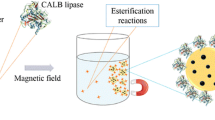Abstract
Magnetic oleic-acid-coated Fe3O4 nanoparticles were first introduced into 1, 1-diphenylethylene (DPE)-controlled radical polymerization system to prepare superparamagnetic microspheres for enzyme immobilization by two steps of polymerization. In the presence of DPE, glycidyl methacrylate, 2-hydroxyethyl methacrylate and methacryloxyethyl trimethyl ammonium chloride with charge were selected as copolymering monomers based on their reactive functional group and excellent biocompatibility which were suitable for immobilization of Candida rugosa lipase (CRL). The resulting magnetic microspheres were characterized by means of scanning electron microscope, Fourier transform infrared spectrum, thermogravimetric analysis and vibrating sample magnetometry. Sodium dodecyl sulfate-polyacrylamide gel electrophoresis SDS-PAGE analysis was also conducted to demonstrate whether CRL is covalently immobilized or only physically adsorbed. The results indicated that the polymerization was successfully carried out, and lipase was immobilized on the magnetic microspheres through ionic adsorption and covalent binding under mild conditions. The immobilized lipase exhibited high activity recovery (69.7%), better resistance to pH and temperature inactivation in aqueous phase, as well as superior reusability in nonaqueous phase. The data showed that the resulting carrier could hold an amphiphilic property.













Similar content being viewed by others
References
Allen CFH, Converse S (1941) 1,1-Diphenylethylene. Org Synth Collect 1:226
Amorim RVS, Melo ES, Carneiro-da-Cunha MG, Ledingham WM, Campos-Takaki GM (2003) Chitosan from Syncephalastrum racemosum used as a film support for lipase immobilization. Bioresour Technol 89(1):35–39
Bradford MM (1976) A rapid and sensitive method for the quantitation of microgram quantities of protein utilizing the principle of protein–dye binding. Anal Biochem 72:248–254
Chen K, Bakuzis A, Luo W (2006) Improving surfactant grafting in magnetic colloids. Appl Surf Sci 252(18):6379–6382
Mateo C, Torres R, FLorente G, Ortiz C, Fuentes M, Hidalgo A, LGallego F, Abian O, Palomo JM, Betancor L, Pessela BCC, Guisan JM, FLafuente R (2003) Epoxy-amino groups: a new tool for improved immobilization of proteins by the epoxy method. Biomacromolecules 4(3):772–777
Ding Y, Hu Y, Zhang L, Chen Y, Jiang X (2006) Synthesis and magnetic properties of biocompatible hybrid hollow spheres. Biomacromolecules 7(6):1766–1772
Dyal A, Loos K, Noto M, Chang SW, Spagnoli C, Shafi KVPM, Ulman A, Cowman M, Gross RA (2003) Activity of Candida rugosa lipase immobilized on γ-Fe2O3 magnetic nanoparticles. J Am Chem Soc 125(7):1684–1685
Feng D, Higashihara T, Faust R (2008) Facile synthesis of diphenylethylene end-functional polyisobutylene and its applications for the synthesis of block copolymers containing poly(methacrylate)s. Polymer 49(2):386–393
Lei L, Bai Y, Li Y, Yi L, Yang Y, Xia C (2009) Study on immobilization of lipase onto magnetic microspheres with epoxy groups. J Magn Magn Mater 321(4):252–258
Lei Z, Bi S (2007) Preparation and properties of immobilized pectinase onto the amphiphilic PS-b-PAA diblock copolymers. J Biotechnol 128(1):112–119
Liu X, Guan Y, Shen R, Liu H (2005) Immobilization of lipase onto micron-size magnetic beads. J Chromatogr B 822(1–2):91–97
Rodriguez-Nogales MJ, Roura E, Contreras E (2005) Biosynthesis of ethyl butyrate using immobilized lipase: a statistical approach. Process Biochem 40(1):63–68
Mooney KE, Nelson JA, Wagner MJ (2004) Superparamagnetic cobalt ferrite nanocrystals synthesized by alkalide reduction. Chem Mater 16(16):3155–3161
Pahujani S, Kanwar S, Chauhan G, Gupta R (2008) Glutaraldehyde activation of polymer nylon-6 for lipase immobilization: enzyme characteristics and stability. Bioresour Technol 99(7):2566–2570
Laemmli UK (1970) Cleavage of structural proteins during the assembly of the head of bacteriophage T4. Nature 227:680–685
Viala S, Antonietti M, Tauer K, Bremser W (2003) Structural control in radical polymerization with 1,1 diphenylethylene: 2. Behavior of MMA–DPE copolymer in radical polymerization. Polymer 44(5):1339–1351
Viala S, Tauer K, Antonietti M, Krüger R-P, Bremser W (2002) Structural control in radical polymerization with 1,1-diphenylethylene. 1. Copolymerization of 1,1-diphenylethylene with methyl methacrylate. Polymer 43(26):7231–7241
Wang Z, Wan L, Liu Z, Huang X, Xu Z (2009) Enzyme immobilization on electrospun polymer nanofibers: an overview. J Mol Catal B Enzym 56(4):189–195
Watanabe N, Ota Y, Minoda Y, Yamada K (1977) Isolation and identification of alkaline lipase producing microorganisms, cultural conditions and some properties of crude enzymes. Agric Biol Chem 41(8):1353–1358
Wieland PC, Raether B, Nuyken O (2001) A new additive for controlled radical polymerization. Macromol Rapid Commun 22(9):700–703
Xu FJ, Neoh KG, Kang ET (2009) Bioactive surfaces and biomaterials via atom transfer radical polymerization. Prog Polym Sci 34(8):719–761
Yamaura M, Camilo RL, Sampaio LC, Macedo MA, Nakamura M, Toma HE (2004) Preparation and characterization of (3-aminopropyl)triethoxysilane-coated magnetite nanoparticles. J Magn Magn Mater 279(2–3):210–217
Yang Y, Bai Y, Li Y, Lin L, Cui Y, Xia C (2008) Preparation and application of polymer-grafted magnetic nanoparticles for lipase immobilization. J Magn Magn Mater 320(19):2350–2355
Ren YZ, Iimura K, Kato T (2001) Structure of barium stearate films at the air/water interface investigated by polarization modulation infrared spectroscopy and π-A isotherms. Langmuir 17(9):2688–2693
Cui YJ, Li YF, Yang Y, Liu X, Lei L, Zhou LC, Pan F (2009) Facile synthesis of amino-silane modified superparamagnetic Fe3O4 nanoparticles and application for lipase immobilization. J Biotechnol 150(1):171–174
Yong Y, Bai Y, Li Y, Lin L, Cui Y, Xia C (2008) Characterization of Candida rugosa lipase immobilized onto magnetic microspheres with hydrophilicity. Process Biochem 43(11):1179–1185
Yu H, Chen H, Wang X, Yang Y, Ching C (2006) Cross-linked enzyme aggregates (CLEAs) with controlled particles: application to Candida rugosa lipase. J Mol Catal B Enzym 43(1–4):124–127
Acknowledgements
The authors would like to thank the National Natural Science Foundation of China (No.21074049) and the Opening Foundation of State Key Laboratory of Applied Organic Chemistry (SKLAOC-2009-35) for the financial supports.
Author information
Authors and Affiliations
Corresponding author
Rights and permissions
About this article
Cite this article
Cui, Y., Chen, X., Li, Y. et al. Novel magnetic microspheres of P (GMA-b-HEMA): preparation, lipase immobilization and enzymatic activity in two phases. Appl Microbiol Biotechnol 95, 147–156 (2012). https://doi.org/10.1007/s00253-011-3745-x
Received:
Revised:
Accepted:
Published:
Issue Date:
DOI: https://doi.org/10.1007/s00253-011-3745-x




